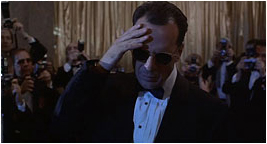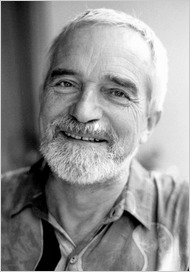VARIETY ARTICLE LOOKS AT POST-BLAIR WITCH DOCUMENTARY TECHNIQUES
 A Variety article by Peter DeBruge, posted a couple of days ago, looks at the evolution of documentary techniques, highlighting recent films such as Redacted, District 9, The Hurt Locker, Bruno, and In The Loop, all films that, according to the article, have evolved the docu-form in the wake of the Blair Witch Project. Below is an excerpt led by thoughts from David Bordwell:
A Variety article by Peter DeBruge, posted a couple of days ago, looks at the evolution of documentary techniques, highlighting recent films such as Redacted, District 9, The Hurt Locker, Bruno, and In The Loop, all films that, according to the article, have evolved the docu-form in the wake of the Blair Witch Project. Below is an excerpt led by thoughts from David Bordwell:Of course, filmmakers didn't wait until 2009 to experiment with documentary techniques. As Bordwell points out, "From World War II on, nearly every country had some sort of neorealist impulse." In America, the crime genre combined docu-style shooting with voice-of-God narration in such late-'40s/early-'50s entries as The Naked City and Panic in the Streets. Later, directors who got their start in documentary, including Stanley Kubrick and William Friedkin, incorporated verite-based techniques in such films as Paths of Glory and The French Connection. "It reaches a culmination in Medium Cool, where you have that immediacy of filming in the Chicago riots," Bordwell adds.
Nearly 40 years later, Brian De Palma advanced the hybrid form with his 2007 Iraq War thriller Redacted, weaving jihadi websites and Al Jazeera-style footage into a tapestry of "found footage" not unlike the elaborate collage of District 9. By comparison, Kathryn Bigelow's The Hurt Locker seems downright conservative, even though it marks a radical departure from the director's more classically constructed earlier work. To achieve the immersive effect she wanted, Bigelow turned to cinematographer Barry Ackroyd, whose background in documentaries had served him well with such verite-inclined directors as Ken Loach (Ladybird Ladybird) and Paul Greengrass (United 93).
"The reason she got in touch with me was because of United 93. She wanted that sense of immediacy and urgency," explains the d.p., who coached Bigelow in Greengrass' strategy of shooting long, continuous takes and letting the action move from one camera to the next. While the actors played close to the script, the camera crew was encouraged to improvise and avoid ever repeating the same take. "If in the end, the shot is out of focus, that's the equivalent of a beautifully framed shot because it betrays the emotion in it," Ackroyd says.
Updated: Sunday, January 17, 2010 8:09 PM CST
Post Comment | Permalink | Share This Post





 Last week's episode of
Last week's episode of 

 Robin Wood, author of the influential book Hollywood from Vietnam to Reagan, died Friday of complications from leukemia. Wood was 78. In the above mentioned book (the title of which can be seen as a direct inspiration to the core of David Greven's new book, Manhood in Hollywood from Bush to Bush) Wood devotes a chapter to Brian De Palma subtitled "The Politics of Castration," in which he states that De Palma's "interesting, problematic, frequently frustrating movies are quite obsessive about castration, either literal or metaphorical." In the chapter, written before Body Double was released, Wood cites Sisters and Blow Out as De Palma's best works. Of the former, Wood wrote, "Simply, one can define the monster of Sisters as women's liberation; adding only that the film follows the time-honored horror film tradition of making the monster emerge as the most sympathetic character and its emotional center." Of Blow Out, Wood concluded that for him, "no film evokes more overwhelmingly the desolation of our culture."
Robin Wood, author of the influential book Hollywood from Vietnam to Reagan, died Friday of complications from leukemia. Wood was 78. In the above mentioned book (the title of which can be seen as a direct inspiration to the core of David Greven's new book, Manhood in Hollywood from Bush to Bush) Wood devotes a chapter to Brian De Palma subtitled "The Politics of Castration," in which he states that De Palma's "interesting, problematic, frequently frustrating movies are quite obsessive about castration, either literal or metaphorical." In the chapter, written before Body Double was released, Wood cites Sisters and Blow Out as De Palma's best works. Of the former, Wood wrote, "Simply, one can define the monster of Sisters as women's liberation; adding only that the film follows the time-honored horror film tradition of making the monster emerge as the most sympathetic character and its emotional center." Of Blow Out, Wood concluded that for him, "no film evokes more overwhelmingly the desolation of our culture." Manhood In Hollywood From Bush To Bush, David Greven's study on Hollywood's representations of masculinity from 1989 to 2009, was published last week by
Manhood In Hollywood From Bush To Bush, David Greven's study on Hollywood's representations of masculinity from 1989 to 2009, was published last week by  Mel Brooks, Robert De Niro, and Bruce Springsteen were three of the artists receiving
Mel Brooks, Robert De Niro, and Bruce Springsteen were three of the artists receiving